Auditing and Assurance Report: Comprehensive Analysis of Elmo Software
VerifiedAdded on 2023/01/03
|12
|2697
|46
Report
AI Summary
This report presents an in-depth analysis of auditing and assurance principles, specifically applied to Elmo Software. Part A of the report focuses on preliminary risk assessment, analytical review of financial performance and position, and the determination of planning materiality, including calculations based on Elmo Software's financial data. Part B evaluates the quality and effectiveness of independent audits, identifying key concerns such as auditor reliance on management information and the impact of management biases. The report also explores how regulators address these concerns through quality reviews and action plans. The analysis includes ratio analysis, assessment of business risks, and a discussion of the importance of materiality in financial reporting. The report concludes with a summary of audit quality improvement initiatives.

Running head: AUDITING AND ASSURANCE
Auditing and Assurance
Name of the Student:
Name of the University:
Author’s Note:
Auditing and Assurance
Name of the Student:
Name of the University:
Author’s Note:
Paraphrase This Document
Need a fresh take? Get an instant paraphrase of this document with our AI Paraphraser

1AUDITING AND ASSURANCE
Table of Contents
Part A: AUDITING AND ASSURANCE.......................................................................................2
Preliminary Risk Assessment......................................................................................................2
Analytical Review.......................................................................................................................3
Planning Materiality....................................................................................................................5
Part B: Quality and Effectiveness of Independent Audit.................................................................6
Concerns on Quality and Effectiveness of Independent Audit....................................................6
Addressing of Audit Concerns by Regulators.............................................................................8
References........................................................................................................................................9
Table of Contents
Part A: AUDITING AND ASSURANCE.......................................................................................2
Preliminary Risk Assessment......................................................................................................2
Analytical Review.......................................................................................................................3
Planning Materiality....................................................................................................................5
Part B: Quality and Effectiveness of Independent Audit.................................................................6
Concerns on Quality and Effectiveness of Independent Audit....................................................6
Addressing of Audit Concerns by Regulators.............................................................................8
References........................................................................................................................................9
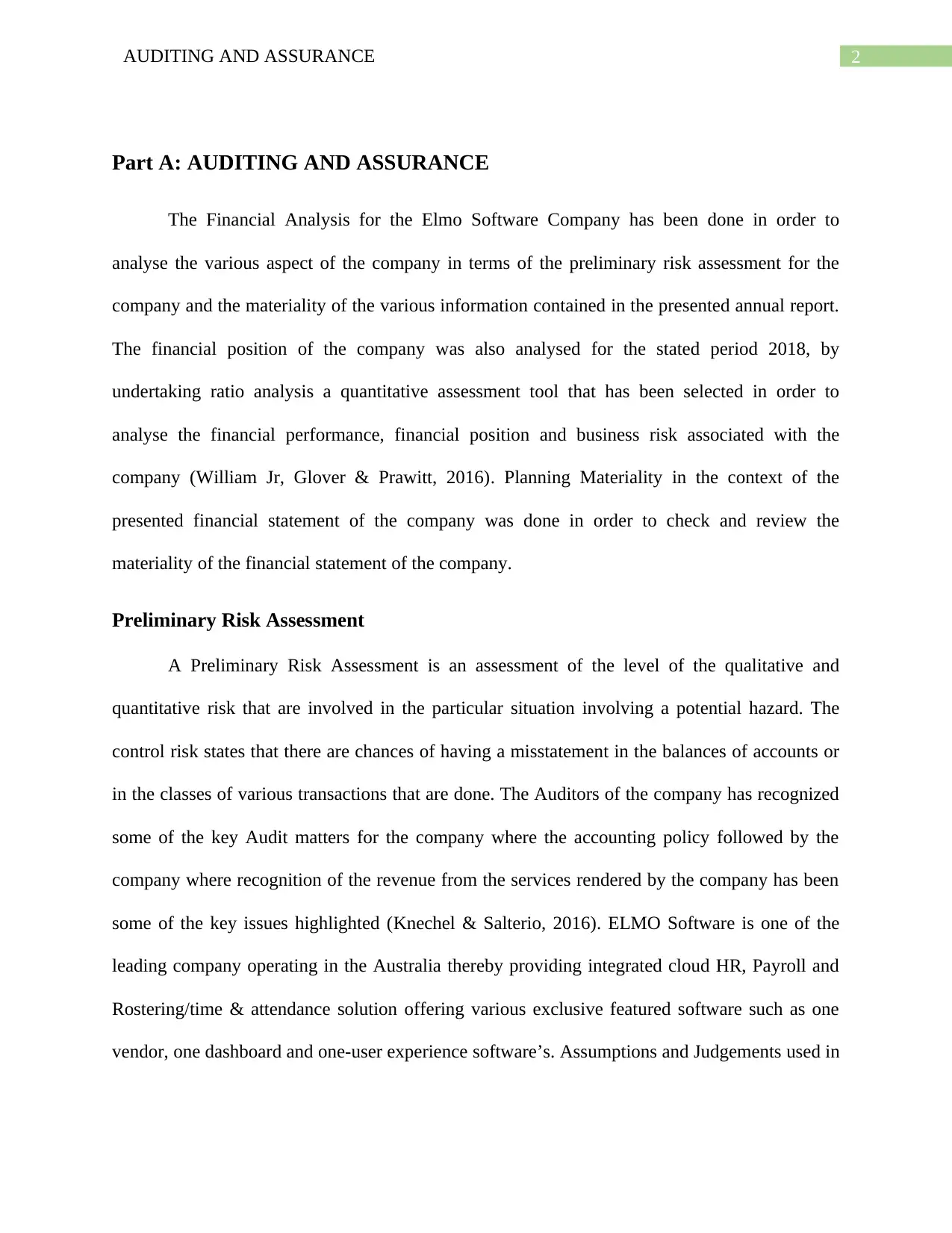
2AUDITING AND ASSURANCE
Part A: AUDITING AND ASSURANCE
The Financial Analysis for the Elmo Software Company has been done in order to
analyse the various aspect of the company in terms of the preliminary risk assessment for the
company and the materiality of the various information contained in the presented annual report.
The financial position of the company was also analysed for the stated period 2018, by
undertaking ratio analysis a quantitative assessment tool that has been selected in order to
analyse the financial performance, financial position and business risk associated with the
company (William Jr, Glover & Prawitt, 2016). Planning Materiality in the context of the
presented financial statement of the company was done in order to check and review the
materiality of the financial statement of the company.
Preliminary Risk Assessment
A Preliminary Risk Assessment is an assessment of the level of the qualitative and
quantitative risk that are involved in the particular situation involving a potential hazard. The
control risk states that there are chances of having a misstatement in the balances of accounts or
in the classes of various transactions that are done. The Auditors of the company has recognized
some of the key Audit matters for the company where the accounting policy followed by the
company where recognition of the revenue from the services rendered by the company has been
some of the key issues highlighted (Knechel & Salterio, 2016). ELMO Software is one of the
leading company operating in the Australia thereby providing integrated cloud HR, Payroll and
Rostering/time & attendance solution offering various exclusive featured software such as one
vendor, one dashboard and one-user experience software’s. Assumptions and Judgements used in
Part A: AUDITING AND ASSURANCE
The Financial Analysis for the Elmo Software Company has been done in order to
analyse the various aspect of the company in terms of the preliminary risk assessment for the
company and the materiality of the various information contained in the presented annual report.
The financial position of the company was also analysed for the stated period 2018, by
undertaking ratio analysis a quantitative assessment tool that has been selected in order to
analyse the financial performance, financial position and business risk associated with the
company (William Jr, Glover & Prawitt, 2016). Planning Materiality in the context of the
presented financial statement of the company was done in order to check and review the
materiality of the financial statement of the company.
Preliminary Risk Assessment
A Preliminary Risk Assessment is an assessment of the level of the qualitative and
quantitative risk that are involved in the particular situation involving a potential hazard. The
control risk states that there are chances of having a misstatement in the balances of accounts or
in the classes of various transactions that are done. The Auditors of the company has recognized
some of the key Audit matters for the company where the accounting policy followed by the
company where recognition of the revenue from the services rendered by the company has been
some of the key issues highlighted (Knechel & Salterio, 2016). ELMO Software is one of the
leading company operating in the Australia thereby providing integrated cloud HR, Payroll and
Rostering/time & attendance solution offering various exclusive featured software such as one
vendor, one dashboard and one-user experience software’s. Assumptions and Judgements used in
⊘ This is a preview!⊘
Do you want full access?
Subscribe today to unlock all pages.

Trusted by 1+ million students worldwide
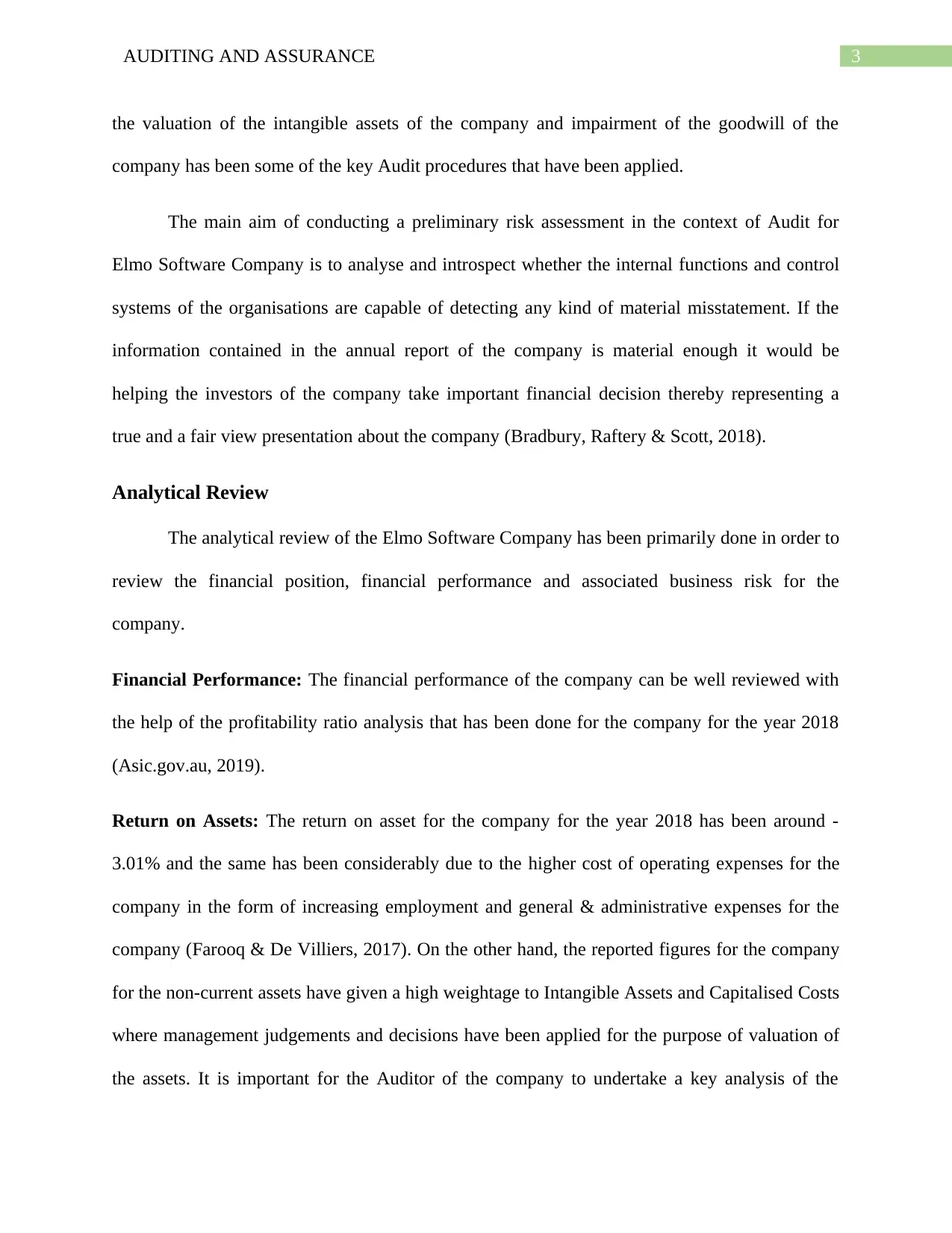
3AUDITING AND ASSURANCE
the valuation of the intangible assets of the company and impairment of the goodwill of the
company has been some of the key Audit procedures that have been applied.
The main aim of conducting a preliminary risk assessment in the context of Audit for
Elmo Software Company is to analyse and introspect whether the internal functions and control
systems of the organisations are capable of detecting any kind of material misstatement. If the
information contained in the annual report of the company is material enough it would be
helping the investors of the company take important financial decision thereby representing a
true and a fair view presentation about the company (Bradbury, Raftery & Scott, 2018).
Analytical Review
The analytical review of the Elmo Software Company has been primarily done in order to
review the financial position, financial performance and associated business risk for the
company.
Financial Performance: The financial performance of the company can be well reviewed with
the help of the profitability ratio analysis that has been done for the company for the year 2018
(Asic.gov.au, 2019).
Return on Assets: The return on asset for the company for the year 2018 has been around -
3.01% and the same has been considerably due to the higher cost of operating expenses for the
company in the form of increasing employment and general & administrative expenses for the
company (Farooq & De Villiers, 2017). On the other hand, the reported figures for the company
for the non-current assets have given a high weightage to Intangible Assets and Capitalised Costs
where management judgements and decisions have been applied for the purpose of valuation of
the assets. It is important for the Auditor of the company to undertake a key analysis of the
the valuation of the intangible assets of the company and impairment of the goodwill of the
company has been some of the key Audit procedures that have been applied.
The main aim of conducting a preliminary risk assessment in the context of Audit for
Elmo Software Company is to analyse and introspect whether the internal functions and control
systems of the organisations are capable of detecting any kind of material misstatement. If the
information contained in the annual report of the company is material enough it would be
helping the investors of the company take important financial decision thereby representing a
true and a fair view presentation about the company (Bradbury, Raftery & Scott, 2018).
Analytical Review
The analytical review of the Elmo Software Company has been primarily done in order to
review the financial position, financial performance and associated business risk for the
company.
Financial Performance: The financial performance of the company can be well reviewed with
the help of the profitability ratio analysis that has been done for the company for the year 2018
(Asic.gov.au, 2019).
Return on Assets: The return on asset for the company for the year 2018 has been around -
3.01% and the same has been considerably due to the higher cost of operating expenses for the
company in the form of increasing employment and general & administrative expenses for the
company (Farooq & De Villiers, 2017). On the other hand, the reported figures for the company
for the non-current assets have given a high weightage to Intangible Assets and Capitalised Costs
where management judgements and decisions have been applied for the purpose of valuation of
the assets. It is important for the Auditor of the company to undertake a key analysis of the
Paraphrase This Document
Need a fresh take? Get an instant paraphrase of this document with our AI Paraphraser
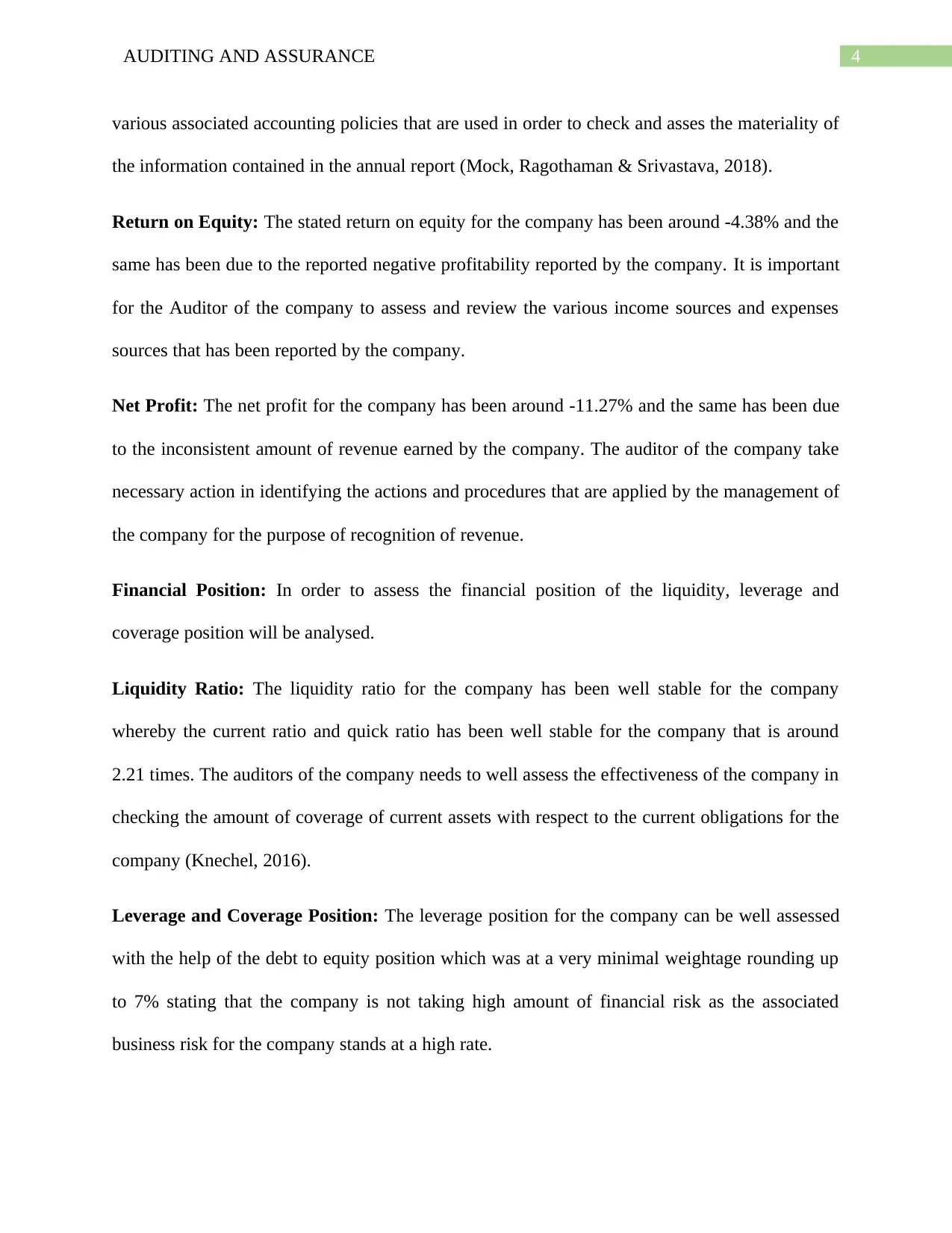
4AUDITING AND ASSURANCE
various associated accounting policies that are used in order to check and asses the materiality of
the information contained in the annual report (Mock, Ragothaman & Srivastava, 2018).
Return on Equity: The stated return on equity for the company has been around -4.38% and the
same has been due to the reported negative profitability reported by the company. It is important
for the Auditor of the company to assess and review the various income sources and expenses
sources that has been reported by the company.
Net Profit: The net profit for the company has been around -11.27% and the same has been due
to the inconsistent amount of revenue earned by the company. The auditor of the company take
necessary action in identifying the actions and procedures that are applied by the management of
the company for the purpose of recognition of revenue.
Financial Position: In order to assess the financial position of the liquidity, leverage and
coverage position will be analysed.
Liquidity Ratio: The liquidity ratio for the company has been well stable for the company
whereby the current ratio and quick ratio has been well stable for the company that is around
2.21 times. The auditors of the company needs to well assess the effectiveness of the company in
checking the amount of coverage of current assets with respect to the current obligations for the
company (Knechel, 2016).
Leverage and Coverage Position: The leverage position for the company can be well assessed
with the help of the debt to equity position which was at a very minimal weightage rounding up
to 7% stating that the company is not taking high amount of financial risk as the associated
business risk for the company stands at a high rate.
various associated accounting policies that are used in order to check and asses the materiality of
the information contained in the annual report (Mock, Ragothaman & Srivastava, 2018).
Return on Equity: The stated return on equity for the company has been around -4.38% and the
same has been due to the reported negative profitability reported by the company. It is important
for the Auditor of the company to assess and review the various income sources and expenses
sources that has been reported by the company.
Net Profit: The net profit for the company has been around -11.27% and the same has been due
to the inconsistent amount of revenue earned by the company. The auditor of the company take
necessary action in identifying the actions and procedures that are applied by the management of
the company for the purpose of recognition of revenue.
Financial Position: In order to assess the financial position of the liquidity, leverage and
coverage position will be analysed.
Liquidity Ratio: The liquidity ratio for the company has been well stable for the company
whereby the current ratio and quick ratio has been well stable for the company that is around
2.21 times. The auditors of the company needs to well assess the effectiveness of the company in
checking the amount of coverage of current assets with respect to the current obligations for the
company (Knechel, 2016).
Leverage and Coverage Position: The leverage position for the company can be well assessed
with the help of the debt to equity position which was at a very minimal weightage rounding up
to 7% stating that the company is not taking high amount of financial risk as the associated
business risk for the company stands at a high rate.
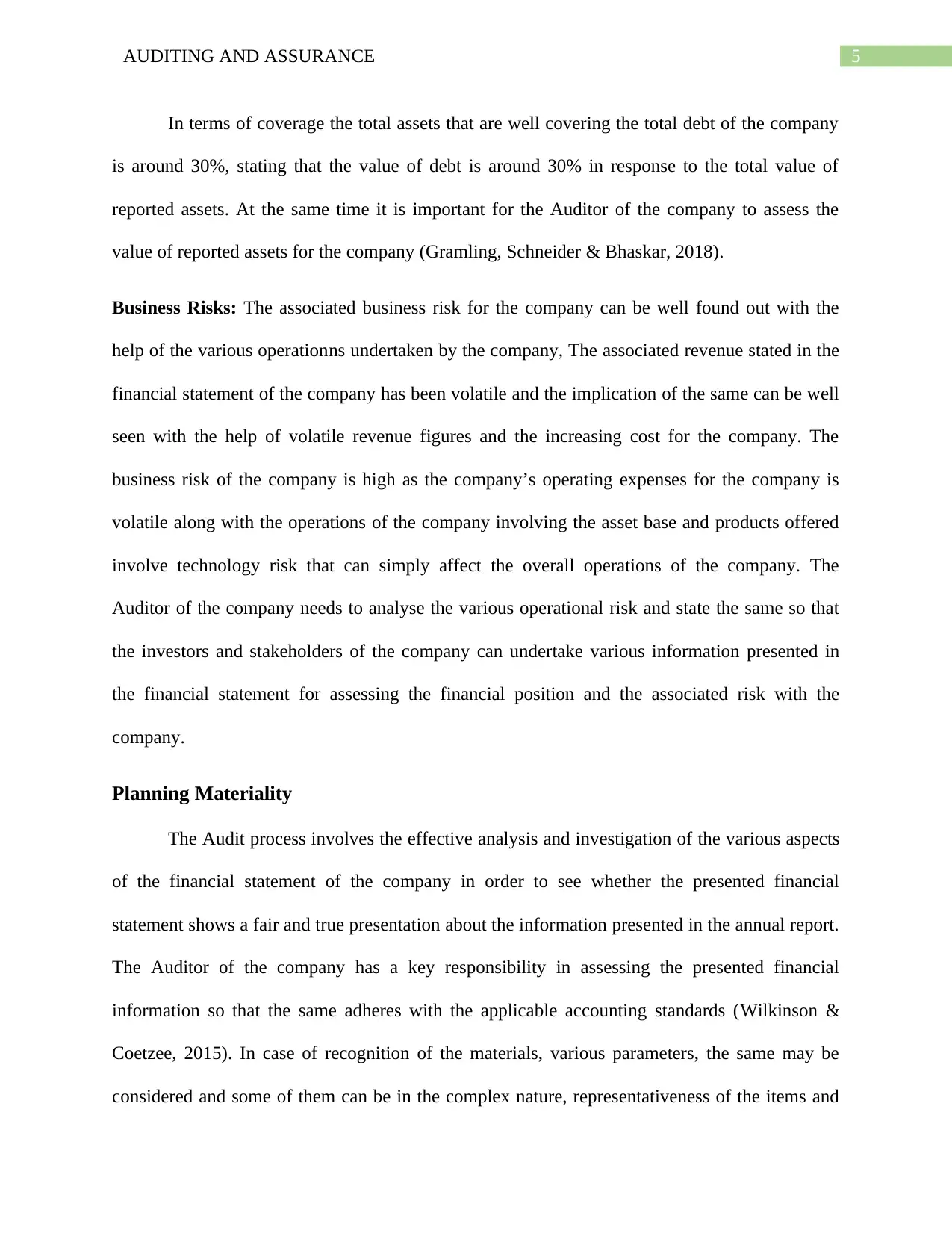
5AUDITING AND ASSURANCE
In terms of coverage the total assets that are well covering the total debt of the company
is around 30%, stating that the value of debt is around 30% in response to the total value of
reported assets. At the same time it is important for the Auditor of the company to assess the
value of reported assets for the company (Gramling, Schneider & Bhaskar, 2018).
Business Risks: The associated business risk for the company can be well found out with the
help of the various operationns undertaken by the company, The associated revenue stated in the
financial statement of the company has been volatile and the implication of the same can be well
seen with the help of volatile revenue figures and the increasing cost for the company. The
business risk of the company is high as the company’s operating expenses for the company is
volatile along with the operations of the company involving the asset base and products offered
involve technology risk that can simply affect the overall operations of the company. The
Auditor of the company needs to analyse the various operational risk and state the same so that
the investors and stakeholders of the company can undertake various information presented in
the financial statement for assessing the financial position and the associated risk with the
company.
Planning Materiality
The Audit process involves the effective analysis and investigation of the various aspects
of the financial statement of the company in order to see whether the presented financial
statement shows a fair and true presentation about the information presented in the annual report.
The Auditor of the company has a key responsibility in assessing the presented financial
information so that the same adheres with the applicable accounting standards (Wilkinson &
Coetzee, 2015). In case of recognition of the materials, various parameters, the same may be
considered and some of them can be in the complex nature, representativeness of the items and
In terms of coverage the total assets that are well covering the total debt of the company
is around 30%, stating that the value of debt is around 30% in response to the total value of
reported assets. At the same time it is important for the Auditor of the company to assess the
value of reported assets for the company (Gramling, Schneider & Bhaskar, 2018).
Business Risks: The associated business risk for the company can be well found out with the
help of the various operationns undertaken by the company, The associated revenue stated in the
financial statement of the company has been volatile and the implication of the same can be well
seen with the help of volatile revenue figures and the increasing cost for the company. The
business risk of the company is high as the company’s operating expenses for the company is
volatile along with the operations of the company involving the asset base and products offered
involve technology risk that can simply affect the overall operations of the company. The
Auditor of the company needs to analyse the various operational risk and state the same so that
the investors and stakeholders of the company can undertake various information presented in
the financial statement for assessing the financial position and the associated risk with the
company.
Planning Materiality
The Audit process involves the effective analysis and investigation of the various aspects
of the financial statement of the company in order to see whether the presented financial
statement shows a fair and true presentation about the information presented in the annual report.
The Auditor of the company has a key responsibility in assessing the presented financial
information so that the same adheres with the applicable accounting standards (Wilkinson &
Coetzee, 2015). In case of recognition of the materials, various parameters, the same may be
considered and some of them can be in the complex nature, representativeness of the items and
⊘ This is a preview!⊘
Do you want full access?
Subscribe today to unlock all pages.

Trusted by 1+ million students worldwide

6AUDITING AND ASSURANCE
the numerical size of the items. The planning materiality of the business and the associated
percentage is well considered for the purpose of computation of the same in the planning stage of
auditing. For computing the planning materiality of the business the base figure for the
computation figures will be considered. The total assets figures reported in the financial
statement of the company for the year 2018 has been around $99,329 and the appropriate
percentage that would be taken in order to determine the overall planning materiality will be
around 2% (Annual Report, 2019). It is essential to note that based on the planning materiality of
the company the performance materiality for the business would be addressed. The performance
materiality shows the materiality benchmark for reflecting whether the reported item is material
or not (Byrnes et al., 2018). The computation of the planning materiality can be well addressed
as shown below:
Planning Materiality=Total Assets of the Company × Percentage estimated
Planning Materiality = $99,329*2%.
Planning Materiality = $1986.58
Thus, the above figure shows that the planning materiality for the business is well
estimated by the Auditor of the company and the same would be used for estimating and
analysing the performance materiality of the business.
Part B: Quality and Effectiveness of Independent Audit
Concerns on Quality and Effectiveness of Independent Audit
Auditing plays an important role in assessing and determining the overall materiality of
the business so that the presented financial statement gives a true and a fair view. The Auditor
the numerical size of the items. The planning materiality of the business and the associated
percentage is well considered for the purpose of computation of the same in the planning stage of
auditing. For computing the planning materiality of the business the base figure for the
computation figures will be considered. The total assets figures reported in the financial
statement of the company for the year 2018 has been around $99,329 and the appropriate
percentage that would be taken in order to determine the overall planning materiality will be
around 2% (Annual Report, 2019). It is essential to note that based on the planning materiality of
the company the performance materiality for the business would be addressed. The performance
materiality shows the materiality benchmark for reflecting whether the reported item is material
or not (Byrnes et al., 2018). The computation of the planning materiality can be well addressed
as shown below:
Planning Materiality=Total Assets of the Company × Percentage estimated
Planning Materiality = $99,329*2%.
Planning Materiality = $1986.58
Thus, the above figure shows that the planning materiality for the business is well
estimated by the Auditor of the company and the same would be used for estimating and
analysing the performance materiality of the business.
Part B: Quality and Effectiveness of Independent Audit
Concerns on Quality and Effectiveness of Independent Audit
Auditing plays an important role in assessing and determining the overall materiality of
the business so that the presented financial statement gives a true and a fair view. The Auditor
Paraphrase This Document
Need a fresh take? Get an instant paraphrase of this document with our AI Paraphraser
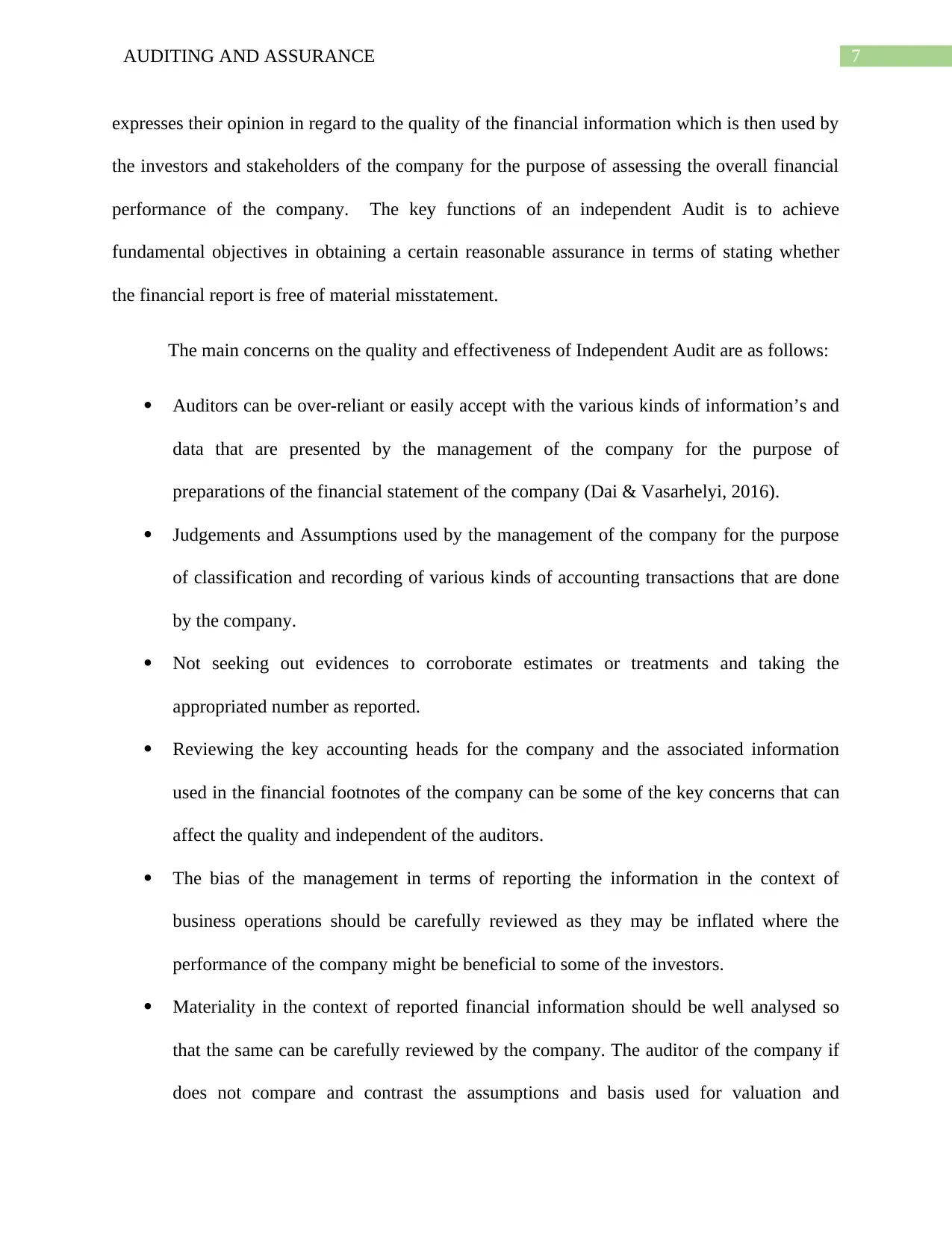
7AUDITING AND ASSURANCE
expresses their opinion in regard to the quality of the financial information which is then used by
the investors and stakeholders of the company for the purpose of assessing the overall financial
performance of the company. The key functions of an independent Audit is to achieve
fundamental objectives in obtaining a certain reasonable assurance in terms of stating whether
the financial report is free of material misstatement.
The main concerns on the quality and effectiveness of Independent Audit are as follows:
Auditors can be over-reliant or easily accept with the various kinds of information’s and
data that are presented by the management of the company for the purpose of
preparations of the financial statement of the company (Dai & Vasarhelyi, 2016).
Judgements and Assumptions used by the management of the company for the purpose
of classification and recording of various kinds of accounting transactions that are done
by the company.
Not seeking out evidences to corroborate estimates or treatments and taking the
appropriated number as reported.
Reviewing the key accounting heads for the company and the associated information
used in the financial footnotes of the company can be some of the key concerns that can
affect the quality and independent of the auditors.
The bias of the management in terms of reporting the information in the context of
business operations should be carefully reviewed as they may be inflated where the
performance of the company might be beneficial to some of the investors.
Materiality in the context of reported financial information should be well analysed so
that the same can be carefully reviewed by the company. The auditor of the company if
does not compare and contrast the assumptions and basis used for valuation and
expresses their opinion in regard to the quality of the financial information which is then used by
the investors and stakeholders of the company for the purpose of assessing the overall financial
performance of the company. The key functions of an independent Audit is to achieve
fundamental objectives in obtaining a certain reasonable assurance in terms of stating whether
the financial report is free of material misstatement.
The main concerns on the quality and effectiveness of Independent Audit are as follows:
Auditors can be over-reliant or easily accept with the various kinds of information’s and
data that are presented by the management of the company for the purpose of
preparations of the financial statement of the company (Dai & Vasarhelyi, 2016).
Judgements and Assumptions used by the management of the company for the purpose
of classification and recording of various kinds of accounting transactions that are done
by the company.
Not seeking out evidences to corroborate estimates or treatments and taking the
appropriated number as reported.
Reviewing the key accounting heads for the company and the associated information
used in the financial footnotes of the company can be some of the key concerns that can
affect the quality and independent of the auditors.
The bias of the management in terms of reporting the information in the context of
business operations should be carefully reviewed as they may be inflated where the
performance of the company might be beneficial to some of the investors.
Materiality in the context of reported financial information should be well analysed so
that the same can be carefully reviewed by the company. The auditor of the company if
does not compare and contrast the assumptions and basis used for valuation and

8AUDITING AND ASSURANCE
reporting of various assets with the applicable accounting standards then the same may
not be material enough for the purpose of including in the financial statement of the
company.
Addressing of Audit Concerns by Regulators
The key audit quality improvement initiatives that are taken by the Regulators are as follows:
Conducting and reviewing the effective quality reviews of the various Audits that are
done for the presented financial statement of the company.
Finding important and necessary information that might be required for the purpose of
classification and obtaining audit evidences for preparing the opinion in comparison to
the financial report presented.
Identifying and implementing root causes of finding quality reviews and various other
Audit reviews.
An action plan should be well designed and implemented by the Auditor for the purpose
of addressing various findings, monitoring and revising the action plans for ensuring that
the plans undertaken are well effective.
Reviewing and Analysing the staff structure for the purpose of ensuring that they are
resourced in an appropriate manner for undertaking various complex audits into the near
term future.
It is important that the Auditor should deliver professional, high quality and professional
scepticism while applying appropriate resources, experiences and various other expertise for the
purpose of auditing. The internal supervision and review system should be sound and effective
so that the same helps the Auditor of the company in noting down various stated important
information’s about the company.
reporting of various assets with the applicable accounting standards then the same may
not be material enough for the purpose of including in the financial statement of the
company.
Addressing of Audit Concerns by Regulators
The key audit quality improvement initiatives that are taken by the Regulators are as follows:
Conducting and reviewing the effective quality reviews of the various Audits that are
done for the presented financial statement of the company.
Finding important and necessary information that might be required for the purpose of
classification and obtaining audit evidences for preparing the opinion in comparison to
the financial report presented.
Identifying and implementing root causes of finding quality reviews and various other
Audit reviews.
An action plan should be well designed and implemented by the Auditor for the purpose
of addressing various findings, monitoring and revising the action plans for ensuring that
the plans undertaken are well effective.
Reviewing and Analysing the staff structure for the purpose of ensuring that they are
resourced in an appropriate manner for undertaking various complex audits into the near
term future.
It is important that the Auditor should deliver professional, high quality and professional
scepticism while applying appropriate resources, experiences and various other expertise for the
purpose of auditing. The internal supervision and review system should be sound and effective
so that the same helps the Auditor of the company in noting down various stated important
information’s about the company.
⊘ This is a preview!⊘
Do you want full access?
Subscribe today to unlock all pages.

Trusted by 1+ million students worldwide
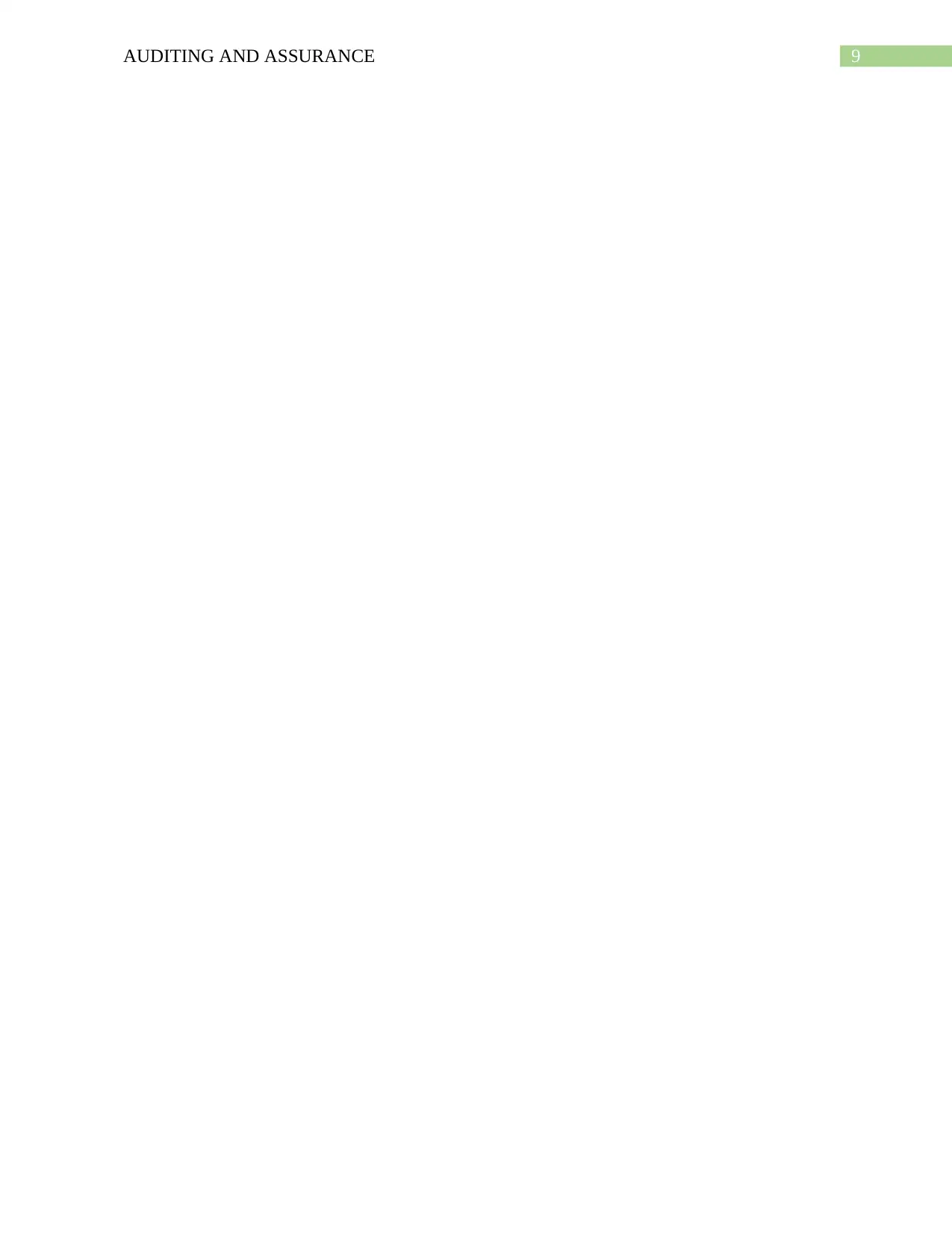
9AUDITING AND ASSURANCE
Paraphrase This Document
Need a fresh take? Get an instant paraphrase of this document with our AI Paraphraser
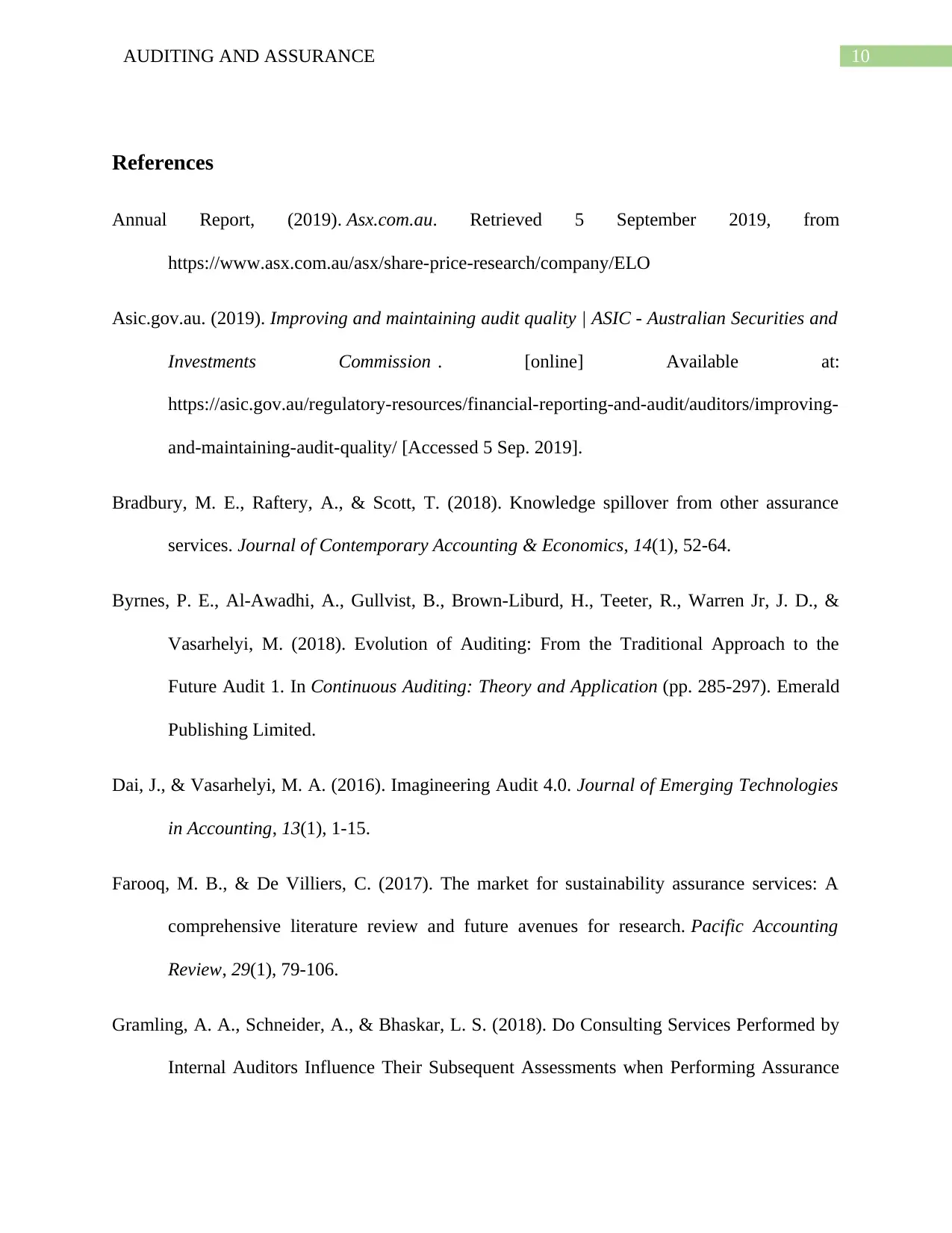
10AUDITING AND ASSURANCE
References
Annual Report, (2019). Asx.com.au. Retrieved 5 September 2019, from
https://www.asx.com.au/asx/share-price-research/company/ELO
Asic.gov.au. (2019). Improving and maintaining audit quality | ASIC - Australian Securities and
Investments Commission . [online] Available at:
https://asic.gov.au/regulatory-resources/financial-reporting-and-audit/auditors/improving-
and-maintaining-audit-quality/ [Accessed 5 Sep. 2019].
Bradbury, M. E., Raftery, A., & Scott, T. (2018). Knowledge spillover from other assurance
services. Journal of Contemporary Accounting & Economics, 14(1), 52-64.
Byrnes, P. E., Al-Awadhi, A., Gullvist, B., Brown-Liburd, H., Teeter, R., Warren Jr, J. D., &
Vasarhelyi, M. (2018). Evolution of Auditing: From the Traditional Approach to the
Future Audit 1. In Continuous Auditing: Theory and Application (pp. 285-297). Emerald
Publishing Limited.
Dai, J., & Vasarhelyi, M. A. (2016). Imagineering Audit 4.0. Journal of Emerging Technologies
in Accounting, 13(1), 1-15.
Farooq, M. B., & De Villiers, C. (2017). The market for sustainability assurance services: A
comprehensive literature review and future avenues for research. Pacific Accounting
Review, 29(1), 79-106.
Gramling, A. A., Schneider, A., & Bhaskar, L. S. (2018). Do Consulting Services Performed by
Internal Auditors Influence Their Subsequent Assessments when Performing Assurance
References
Annual Report, (2019). Asx.com.au. Retrieved 5 September 2019, from
https://www.asx.com.au/asx/share-price-research/company/ELO
Asic.gov.au. (2019). Improving and maintaining audit quality | ASIC - Australian Securities and
Investments Commission . [online] Available at:
https://asic.gov.au/regulatory-resources/financial-reporting-and-audit/auditors/improving-
and-maintaining-audit-quality/ [Accessed 5 Sep. 2019].
Bradbury, M. E., Raftery, A., & Scott, T. (2018). Knowledge spillover from other assurance
services. Journal of Contemporary Accounting & Economics, 14(1), 52-64.
Byrnes, P. E., Al-Awadhi, A., Gullvist, B., Brown-Liburd, H., Teeter, R., Warren Jr, J. D., &
Vasarhelyi, M. (2018). Evolution of Auditing: From the Traditional Approach to the
Future Audit 1. In Continuous Auditing: Theory and Application (pp. 285-297). Emerald
Publishing Limited.
Dai, J., & Vasarhelyi, M. A. (2016). Imagineering Audit 4.0. Journal of Emerging Technologies
in Accounting, 13(1), 1-15.
Farooq, M. B., & De Villiers, C. (2017). The market for sustainability assurance services: A
comprehensive literature review and future avenues for research. Pacific Accounting
Review, 29(1), 79-106.
Gramling, A. A., Schneider, A., & Bhaskar, L. S. (2018). Do Consulting Services Performed by
Internal Auditors Influence Their Subsequent Assessments when Performing Assurance
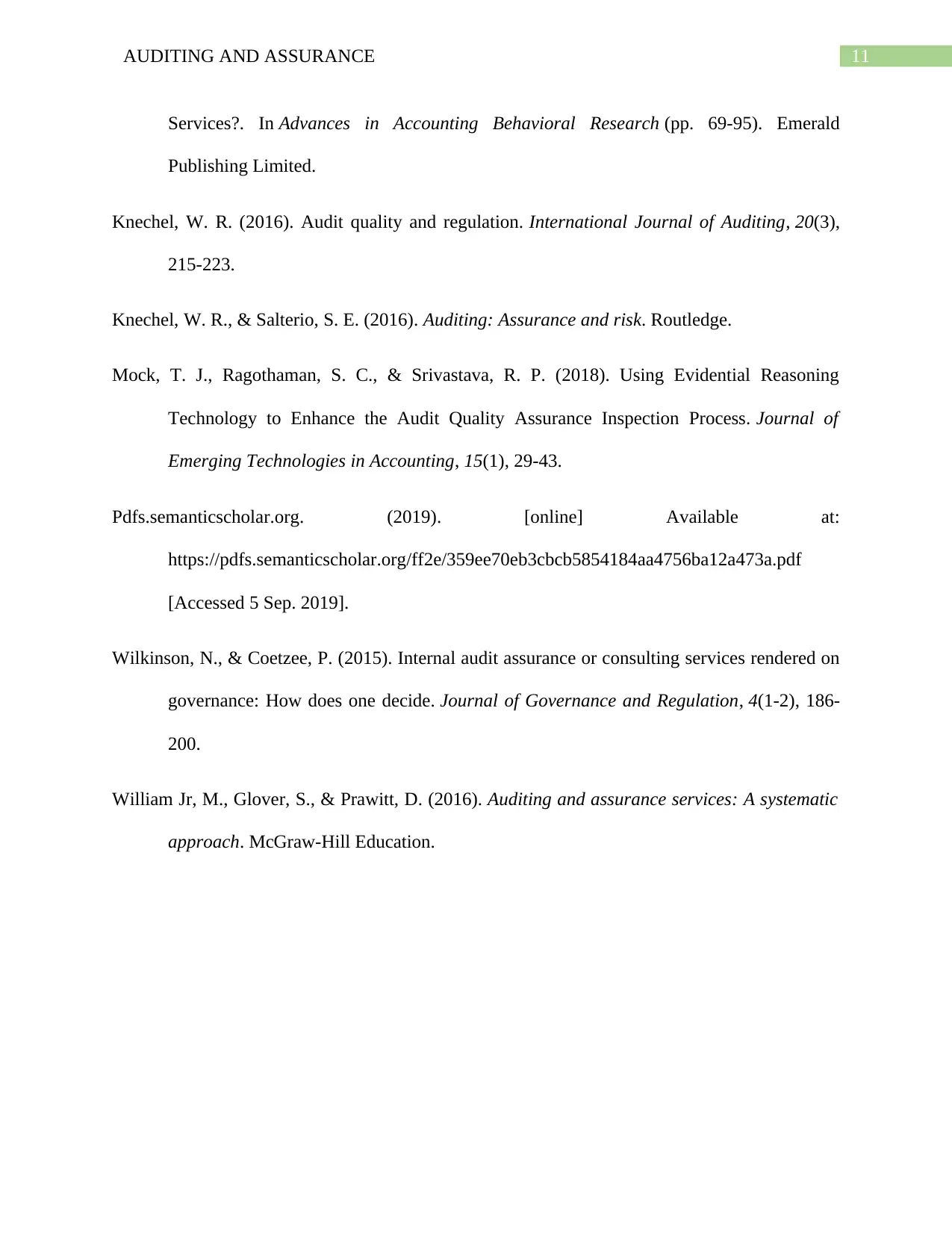
11AUDITING AND ASSURANCE
Services?. In Advances in Accounting Behavioral Research (pp. 69-95). Emerald
Publishing Limited.
Knechel, W. R. (2016). Audit quality and regulation. International Journal of Auditing, 20(3),
215-223.
Knechel, W. R., & Salterio, S. E. (2016). Auditing: Assurance and risk. Routledge.
Mock, T. J., Ragothaman, S. C., & Srivastava, R. P. (2018). Using Evidential Reasoning
Technology to Enhance the Audit Quality Assurance Inspection Process. Journal of
Emerging Technologies in Accounting, 15(1), 29-43.
Pdfs.semanticscholar.org. (2019). [online] Available at:
https://pdfs.semanticscholar.org/ff2e/359ee70eb3cbcb5854184aa4756ba12a473a.pdf
[Accessed 5 Sep. 2019].
Wilkinson, N., & Coetzee, P. (2015). Internal audit assurance or consulting services rendered on
governance: How does one decide. Journal of Governance and Regulation, 4(1-2), 186-
200.
William Jr, M., Glover, S., & Prawitt, D. (2016). Auditing and assurance services: A systematic
approach. McGraw-Hill Education.
Services?. In Advances in Accounting Behavioral Research (pp. 69-95). Emerald
Publishing Limited.
Knechel, W. R. (2016). Audit quality and regulation. International Journal of Auditing, 20(3),
215-223.
Knechel, W. R., & Salterio, S. E. (2016). Auditing: Assurance and risk. Routledge.
Mock, T. J., Ragothaman, S. C., & Srivastava, R. P. (2018). Using Evidential Reasoning
Technology to Enhance the Audit Quality Assurance Inspection Process. Journal of
Emerging Technologies in Accounting, 15(1), 29-43.
Pdfs.semanticscholar.org. (2019). [online] Available at:
https://pdfs.semanticscholar.org/ff2e/359ee70eb3cbcb5854184aa4756ba12a473a.pdf
[Accessed 5 Sep. 2019].
Wilkinson, N., & Coetzee, P. (2015). Internal audit assurance or consulting services rendered on
governance: How does one decide. Journal of Governance and Regulation, 4(1-2), 186-
200.
William Jr, M., Glover, S., & Prawitt, D. (2016). Auditing and assurance services: A systematic
approach. McGraw-Hill Education.
⊘ This is a preview!⊘
Do you want full access?
Subscribe today to unlock all pages.

Trusted by 1+ million students worldwide
1 out of 12
Related Documents
Your All-in-One AI-Powered Toolkit for Academic Success.
+13062052269
info@desklib.com
Available 24*7 on WhatsApp / Email
![[object Object]](/_next/static/media/star-bottom.7253800d.svg)
Unlock your academic potential
Copyright © 2020–2025 A2Z Services. All Rights Reserved. Developed and managed by ZUCOL.




